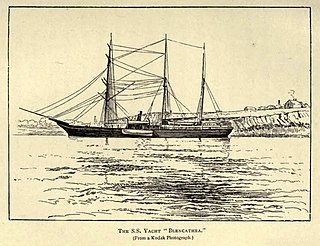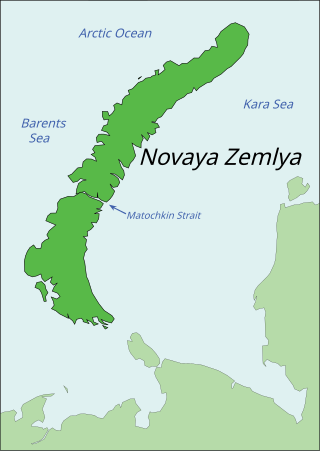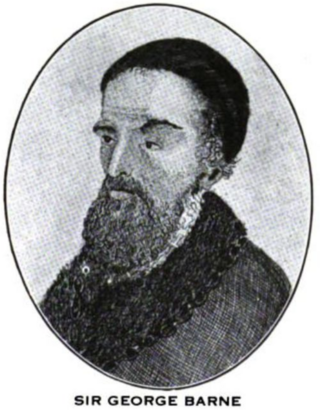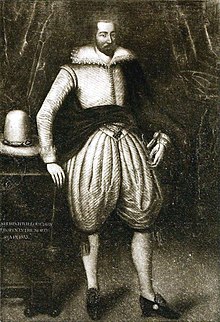
Henry Hudson was an English sea explorer and navigator during the early 17th century, best known for his explorations of present-day Canada and parts of the northeastern United States.

Willem Barentsz, anglicized as William Barents or Barentz, was a Dutch navigator, cartographer, and Arctic explorer.

The Muscovy Company was an English trading company chartered in 1555. It was the first major chartered joint-stock company, the precursor of the type of business that would soon flourish in England and finance its exploration of the world. The Muscovy Company had a monopoly on trade between England and Russia until 1698 and it survived as a trading company until the Russian Revolution. Since 1917, the company has operated as a charity, now working within Russia.
Steven Borough was an English navigator and an early Arctic explorer. He was master of the first English ship to reach the White Sea in 1553 and open trade with Russia on behalf of the Muscovy Company. He became an expert on piloting in Arctic waters and was one of the earliest English practitioners of the new scientific methods of navigation. He was widely sought out for his knowledge by English and Spanish mariners.

Richard Chancellor was an English explorer and navigator; the first to penetrate to the White Sea and establish relations with the Tsardom of Russia.
The Company of Merchant Adventurers to New Lands was an early joint stock association, which began with private exploration and enterprise, and was to have been incorporated by King Edward VI in 1553, but received its full royal charter in 1555. It led to the commencement of English trade with Russia, Persia and elsewhere, and became known informally, and later formally, as the Muscovy Company.

Vladimir Ivanovich Voronin was a Soviet Navy captain, born in Sumsky Posad, in the present Republic of Karelia, Russia. In 1932 he commanded the expedition of the Soviet icebreaker A. Sibiryakov which made the first successful crossing of the Northern Sea Route in a single navigation without wintering. This voyage was organized by the All-Union Arctic Institute.

Anthony Jenkinson was born at Market Harborough, Leicestershire. He was one of the first Englishmen to explore Muscovy and present-day Russia. Jenkinson was a traveller and explorer on behalf of the Muscovy Company and the English crown. He also met Ivan the Terrible several times during his trips to Moscow and Russia. He detailed the accounts of his travel through several written works over his life.

The Philomel-class gunvesselHMS Newport was launched in Wales in 1867. Having become the first ship to pass through the Suez Canal, she was sold in 1881 and renamed Pandora II. She was purchased again in about 1890 and renamed Blencathra, taking part in expeditions to the north coast of Russia. She was bought in 1912 by Georgy Brusilov for use in his ill-fated 1912 Arctic expedition to explore the Northern Sea Route, and was named Svyataya Anna, after Saint Anne. The ship became firmly trapped in ice; only two members of the expedition, Valerian Albanov and Alexander Konrad, survived. The ship has never been found.

Novaya Zemlya is an archipelago in northern Russia. It is situated in the Arctic Ocean, in the extreme northeast of Europe, with Cape Flissingsky, on the northern island, considered the easternmost point of Europe. To Novaya Zemlya's west lies the Barents Sea and to the east is the Kara Sea.

During his 1553 voyage across the Barents Sea, English explorer Hugh Willoughby thought he saw islands to the north. Based on his description, these islands were subsequently depicted and named "Willoughby's Land" and "Macsinof Island" on maps published by Petrus Plancius in 1592 and 1594. Gerardus Mercator included them on his 1595 map. Willem Barentsz found no sign of Willoughby's discoveries and omitted them from his map published in 1599, but they continued to appear on Arctic maps published by Jan Janssonius and Willem Blaeu at least into the 1640s.
During his 1553 voyage across the Barents Sea, English explorer Hugh Willoughby thought he saw islands to the north. Based on his description, these islands were subsequently depicted and named "Willoughby's Land" and "Macsinof Island" on maps published by Petrus Plancius in 1592 and 1594. Gerardus Mercator included them on his 1595 map. Willem Barentsz found no sign of Willoughby's discoveries and omitted them from his map published in 1599, but they continued to appear on Arctic maps published by Jan Janssonius and Willem Blaeu at least into the 1640s. Macsinof Island also appears as Macsin or Matsyn Island.
Clement Adams was an English schoolmaster and author, noted for producing an engraving of Sebastian Cabot's map of the world, sometime after 1544.

Arctic exploration is the physical exploration of the Arctic region of the Earth. It refers to the historical period during which mankind has explored the region north of the Arctic Circle. Historical records suggest that humankind have explored the northern extremes since 325 BC, when the ancient Greek sailor Pytheas reached a frozen sea while attempting to find a source of the metal tin. Dangerous oceans and poor weather conditions often fetter explorers attempting to reach polar regions, and journeying through these perils by sight, boat, and foot has proven difficult.

Vardøya is an island in Vardø Municipality in Finnmark county, Norway. The 3.7-square-kilometre (1.4 sq mi) island is the location of the town of Vardø. The island sits about 1.5 kilometres (0.93 mi) east of the mainland Varanger Peninsula. The island is connected to the mainland by the Vardø Tunnel, the first subsea tunnel that was built in Norway. The tunnel is part of the European route E75 highway, which has its terminus at the town of Vardø. The small island of Hornøya is 1.5 kilometres (0.93 mi) to the northeast of Vardøya.
John Lok was the son of Sir William Lok, the great-great-great-grandfather of the philosopher John Locke (1632–1704). In 1554 he was captain of a trading voyage to Guinea. An account of his voyage was published in 1572 by Richard Eden.
Edward Bonaventure was an English ship under the command of Richard Chancellor that was forced to seek shelter in 1553 on the north coast of Russia near Nyonoksa due to weather conditions, leading to its crew coming into contact with the court of Ivan the Terrible, the forming of the Muscovy Company, and diplomatic contacts between Elizabeth I of England and Ivan of Russia.
Arthur Pet and Charles Jackman were English explorers. They led an expedition for the Muscovy Company to discover the Northeast Passage in 1580.

Sir George Barne was an English businessman in the City of London who was active in developing new trading links with Russia, West Africa and North America, far outside what had been traditional English trading patterns. Created a knight in 1553, he served as Sheriff of London and Lord Mayor of London. He was the father of Sir George Barne and grandfather of Sir William Barne. Nicholas Culverwell was probably a nephew.












